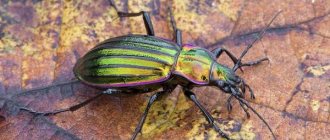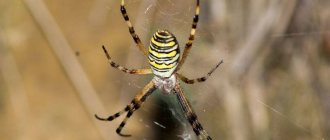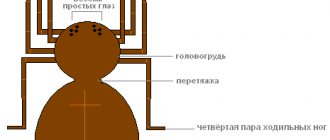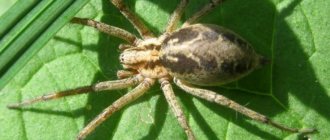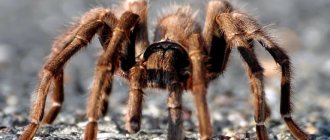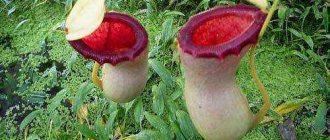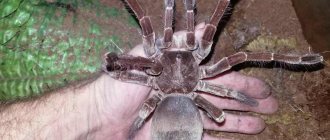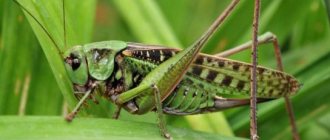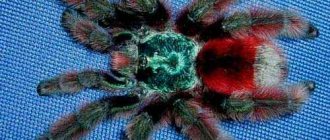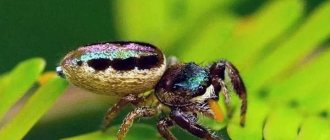Spiders represent a whole order of predatory animals that eat exclusively living organisms. As a rule, spiders catch these insects on their own. At the same time, they are not interested in inanimate objects.
Interesting to know! Scientists know about more than 42 thousand species of these animals living on our planet. Although no one knows the exact number. There are still plenty of unexplored places on our planet, and new species of small living organisms are discovered almost every day. In addition, spiders are excellent at camouflage.
All varieties of arthropods have differences from each other in their size, in the size of their paws, in the shape and size of the chelicerae, as well as in the degree of toxicity. The spider's body can be smooth or covered with bristles of varying lengths. At the same time, spiders can form webs or live in burrows, but all of them have main characteristics that allow them to be classified as arachnids.
General signs
As a rule, an ordinary spider has 6 pairs of limbs, but a person can notice only 4 pairs, since the organs of nutrition and touch are formed from the first 2 of them. The animal's body has 2 sections - the cephalothorax and abdomen, which are connected to each other by a thin bridge. If you carefully examine the spider, you will find that the cephalothorax also has a certain division into the chest and head parts using a thin groove. Limbs grow on the chest part, due to which the animal moves and weaves a web.
Interesting fact! Classic spiders always have a spinning organ.
On the head of the spider there are:
- Chelicerae formed by the first pair of limbs.
- Pedipalps formed from the second pair of limbs. They serve for the spider both as an organ of touch and as a tool for catching and holding insects.
- Eyes.
- Oral apparatus.
The majority of species have 8 eyes, although the number of eyes depends on the habitat. So, spiders that live in caves where the sun's rays do not reach do not have eyes as such.
Interesting to know! Oddly enough, the reproductive organs of spiders are also located on the pedipalps.
Reproduction of arthropods
Arachnids are heterosexual. Males are smaller than females and have brighter colors. The reproductive organs are located in front of the spinning glands.
Males demonstrate their interest in mating in various ways (for example, by clinking their legs on the web). If the female accepts the call, she gives permission to approach her.
After mating, the male must leave the female. It is not uncommon for a female to eat her boyfriend after fertilization.
Development of spiders.
Ways to deal with house spiders
All arachnids are sensitive to the action of chemicals. The most popular are Butox 50, dichlorvos, Neoron, Dobrokhim FOS. There should be no children or animals in the room during treatment.
After spraying the product, do not enter the rooms for 30 minutes. Then you can ventilate the house by opening the windows. All surfaces must be thoroughly wiped.
What does “Yastreb” offer?
The Yastreb company offers a more effective way to combat spiders and other insects. This is the Yastreb MT.04 device. It needs to be plugged into a power outlet and left to work.
It is not dangerous for pets and people. Can be used for a long time, protecting your home from all types of insects. Its name is easy to remember, and it will be invisible in the room due to its compact size.
Repeller “Hawk MT.04”.
Why is it profitable and convenient?
The device has 3 operating modes. The first of them helps to cope with insects in a short time. You cannot use it constantly - the parasites develop immunity. It is advisable to use this regimen during the first week from the start of use.
Varable1 – fast frequency conversion. Insects cannot get used to this mode, and it can be used for a long time.
Varable2 converts frequencies slowly without causing addiction. Suitable for large spaces. It is allowed to use the device in this mode for up to 4 weeks.
“Yastreb MT.04” is suitable for any area of the house.
It can be used both in winter and summer. Operates from household power supply. Light weight and size make it universal for any interior.
The internal structure of the body of spiders
Spiders are distinguished by the fact that they do not have a full-fledged circulatory system, as well as no blood, which is replaced by lymph. There is a heart, but a peculiar one, consisting of 3 or 4 holes, called awns. Through these openings, lymph enters the heart area, after which it is distributed throughout the body into the spaces between the internal organs. After this, the lymph enters the pericardial region of the body and is sent back to the heart. With the help of lymph, the spider receives the necessary portion of oxygen.
The spider's respiratory organ also has a unique structure. The respiratory system consists of plate-shaped pulmonary sacs that resemble books. The breathing holes are protected by special covers that open at the right time. The respiratory system also includes trachea tubes, which supply oxygen to the internal organs.
Spiders, despite the fact that they are predators, have a well-developed central nervous system consisting of nerve cells. Nerve formations are located in the cephalothorax, and from them nerve endings are distributed, directed to all organs of the animal. These nodes, the number of which is 2, are the brain of the animal.
It is important to know! The number of nerve cells is very significant, since the volume of the brain accounts for up to 30% of the useful volume of the cephalothorax.
External structure
External structure of a spider
Spiders are heterosexual, and in most species the males are smaller than the females. This is due to the fact that when creating offspring of a female, it is then easier to eat the partner and produce more cubs. At the back are the warts, from which the warts stand out.
Body
The body consists of a cephalothorax covered with chitin, a hard exoskeleton. During its life, it can be updated up to 10 times, and the old one is reset only after a new one is formed under it.
Limbs
Spiders have four pairs of legs covered with small hairs.
There are also two pedipalps on the body, which are responsible for the sense of smell. Next to the jaws there are also chelicerae, with the help of which the predator injects poison into the prey. Interesting fact : thanks to the hairs on its limbs, the spider senses the direction of the wind and orients itself in space.
Color
The main components that determine the spider's color are bilin and guanine. They add brown and white to the body respectively. Also, other shades appear due to the light reflection characteristics of the hairs on the body.
How do spiders feed?
Spiders are obligate predators because they catch prey on their own, but they do not have teeth. As a rule, the victim herself falls into the web and the spider has to use its poison to eat the prey. The peculiarity of the poison is that it dissolves the flesh of the victim, making it a kind of broth. In addition, the poison serves to immobilize the victim. As a rule, all spiders are poisonous, but few pose a danger to humans.
Amazing spiders. Amazing spiders 2015 HDTVRip
Karakurt spider - Latrodectus tredecimguttatus
photo of karakurt
This is not a big black spider at all. The body of the female (10-20 mm) is completely black, which is why she is also called a black widow, the body of the male (4-7 mm) is also black, but with bright red spots on the abdomen (usually 13 spots ). The karakurt spider lives in Central Asia, Iran, Afghanistan, on the shores of the Mediterranean Sea, North Africa, Southern Europe, Kazakhstan, southern Russia and Ukraine. They prefer the slopes of ravines, virgin wormwood, wastelands, and the banks of irrigation ditches. Karakurts inhabit abandoned rodent burrows and ventilation systems, entwining the entrance with cobwebs. In such dens, females and males mate at the end of summer. The female lays her eggs in a cocoon of cobwebs and hangs it in her den. In spring, spiderlings emerge from cocoons. Karakurts feed on small insects. Their venom is toxic to large animals and people. There is a burning sensation and swelling at the site of the bite. After 10-15 minutes, the poison spreads throughout the body and the person experiences pain in the chest and abdominal area. Dizziness, nausea, sweating, rapid heartbeat, and delirium also occur. And if medical assistance is not provided in time, death is possible (in most cases). Karakurt bites through the skin only 0.5 mm, so it is recommended to cauterize the bite site with a lit match within 2 minutes after the bite.
What types of spiders are there?
These arthropods are found in any living conditions, so they are found literally everywhere: in the ground, on trees, on bushes, in caves, etc. The only thing is that they cannot fly, although some species easily move through space on their webs. At the same time, arthropods can cover enormous distances.
Conventionally, spiders are divided into several groups. For example:
- On those living in burrows.
- Living on the surface of the earth.
- Living under bushes.
- Tree dwellers.
Tree spiders can be easily identified by the shape of their web, which resembles a target. Spiders that live in burrows use webs to secure the soil so that it does not collapse. Spiders that live on the surface of the earth form webs horizontally, using pieces of soil for reliability. Those that live under bushes weave webs in the form of huts, and they camouflage it with the help of branches and earth. Arthropods use all forms of webs as a signaling system, which signals that living creatures have been caught in the trap.
Interesting to know! The silverback spider is the only species that can live in water.
What causes spiders to appear at home?
The main habitat of arthropods is forests, fields and gardens. There they find food, weave webs and lay eggs. These residents settle in the house if there are favorable conditions for existence.
The main reason for the appearance of a spider in an apartment is a large amount of food. If there are midges, mosquitoes or flies in the room, then the arthropod will firmly settle in one of the dark corners.
Spiders love darkness, humidity and coolness. Therefore, in the house they are often located behind sofas, armchairs or under radiators. In this case, you can get rid of insects by frequent cleaning - removing cobwebs in all corners.
A man brings small spiders on his clothes and shoes from the street. But if the house does not have suitable living conditions, then they will not stay long.
Help prevent spiders in your home
Repellers will help prevent the spread of arthropods in the house. The most effective device will be the Yastreb company, which is plugged into an outlet. It is easy to use and not dangerous to humans and animals.
In addition, you need to take out the trash in a timely manner, throw away old things and faulty equipment. All this attracts arachnids and gives them a wonderful place to live.
Interesting classification
Everyone knows that there are lovers of large tarantula spiders who classify their favorites depending on their speed characteristics. For example:
- For Dummies" . These are slow-moving members of this species that many people like to film. They can sit quietly on the palm of a person and move extremely slowly.
- For the “advanced” . These arthropods move quite quickly, so it’s unlikely to be captured on video.
- For professionals . They move so quickly that it is unlikely to notice in which direction the arthropod disappeared.
If we take into account such speed characteristics, it is not difficult to imagine how many species humanity does not yet know about.
THE STRANGE AND UNUSUAL SPIDERS IN THE WORLD
Camel spider - Camel spider
Camel spider photo
The camel spider has many names: phalanges, bihors, salpugs, barbers, barbers, wind scorpion. The body (5-7 cm) is slightly oblong, light and dark red, densely covered with long, thin hairs. The camel spider's body shape is similar to a scorpion, especially with its chelicerae (claws). With them he is able to bite through a human nail and even small bird bones. He also uses his chelicerae to trim hairs and feathers from his victims and place them in his home. The camel spider lives in the desert regions of Asia, Africa, America, and Europe. Phalanx spider is a nocturnal predator. It is practically omnivorous and carnivorous, feeding on various insects, rodents, and lizards. Camel spiders have eyes like scorpions: 2 compound eyes in the middle and one on each side of the cephalothorax. Compound eyes are highly responsive to movement, so these spiders are incredibly fast, up to 53 cm/s (1.9 km/h). The camel spider is not poisonous, but it does have an incredibly painful bite. And also on its chelicerae the remains of the tissues of the previous victim can rot, which can cause serious inflammation.
Deadly poisonous spiders
As a rule, the majority of spider species are not dangerous to humans. The only problem is the presence of cobwebs in the most inappropriate places for humans. It should be noted that there are very poisonous species, the bites of which can be fatal to humans.
Deadly ones include:
- Black widow, as well as karakurt.
- Brazilian spiders.
- Brown recluse spider.
Black widows received such an interesting name due to the fact that after mating, if the male does not have time to leave, the female simply eats him. This dangerous species is distributed across almost all continents. They hunt their prey like a lasso using their web. The most famous in this regard is the American black widow, and as for the other representatives of this genus, they do not pose a serious danger.
North American black widow
On the North American continent, you can find up to 5 species of black widows, which are distinguished by their black body color with the presence of red spots on the abdomen.
It is important to know! Not all black widows are distinguished by their black body color.
The main distinguishing feature of this kind of spider is the presence of long legs, as evidenced by photographs of these dangerous animals. A spider bite is somewhat similar to a pin prick, but after 30 minutes muscle cramps appear that spread throughout the body. When serums had not yet been invented, up to 5% of victims died from their bites.
South American black widows
Representatives of this genus, living in South and Central America, have been studied very little. It is known that up to 8 species live in these places. This is due to the fact that spiders inhabit hard-to-reach places that are not so easy to reach.
Karakurt
These poisonous and dangerous arthropods live in Eurasia and Africa. There are up to 18 varieties of them, differing in varying degrees of danger. These are the same black widows, but they are called karakurt here. Black karakurt prefers to live in the southern regions of the continent, including Crimea and the Mediterranean. Due to the fact that global warming processes are observed on the planet, black karakurt was found in colder regions. As a rule, the ideal conditions for this arthropod to live are high temperatures above zero.
The image and name of the spiders do not correspond to reality, since these types of karakurts are distinguished by the presence of large red spots on the back. The coloring of spiders can vary due to the fact that Eurasian species often interbreed. As a result, black karakurt can have a pure black color.
Interesting fact! In nature, there is also a white karakurt. This type of karakurt is not so poisonous, but children and allergy sufferers can suffer from their bites. They live in the same conditions as black karakurts.
Oceania and Australia
The Australian black widow is considered one of the most poisonous representatives of arthropods.
Latrodectus geometricus
The black widow of this species is distributed on almost all continents. If you look from the back, the spider is brown in color, and the red spot is located on the lower part of the abdomen. This black widow's paws are yellow-brown, and black stripes can be seen on their bends. Of all the representatives of this genus, it is considered the least dangerous creature and poses a danger only to children and the elderly.
Brazilian wandering spider
Until recently, it was believed that black widows were the most dangerous species of spider, but by 2010, the most dangerous species became known - the Brazilian soldier spider. The genus of these most dangerous arthropods includes about 8 species. Their habitat is limited to the tropics of South and Central America. The most interesting thing is that spiders of this species build hunting webs and hunt in an active way.
Interesting fact! The last species of these arthropods was discovered only in 2001.
After being bitten by a soldier spider, paralysis and suffocation occur. As a result of poison entering the blood, in 85 cases out of 100, complete cardiac arrest occurs.
Recluse spider
This is one of the species that represents the North American continent. Body color can be either brown or dark yellow or gray. The size of the paws can range from 6 to 20 mm. The recluse spider has only 6 eyes, compared to the majority of species. This can be seen in the photo if you enlarge the image.
During the daytime it prefers to be in shelter, and goes out hunting in the dark. Despite the fact that he does not hunt with the help of a web, he still weaves a web, but uses it as a shelter. It can easily be found in a person’s home, so it can easily climb into bed. If you press him down, he will certainly bite.
Over time, a necrotic ulcer forms at the site of the bite, which can heal for several years. There are also fatal cases when a child or a person with weak immunity becomes a victim of a bite.
10 Most Dangerous Spiders in the World
Reproduction and life cycle
All representatives reproduce by laying eggs. Males do not have a penis. They have to drain the seminal fluid into a reservoir made from the web. They pick it up with the pedipalps. How spiders reproduce:
- Marriage games. If the behavior of the male does not correspond to the species, then the female may mistake the suitor for prey and eat it.
- The male transfers the seed from the abdominal cavity.
- Attached to the female with the help of growths on the limbs.
- Inserts the pedipalp into the female's genital opening and fertilizes. Spider sperm are packed in sacs.
- The seed capsules end up in a sperm storage container.
- From there, the fallopian tubes lead to the ovaries, which can be paired or unpaired.
- The eggs grow on the surface of the ovaries.
- The ripened ones move inside them.
- From there they go out through the oviducts.
- The female wraps them in a web, hides them or carries them with her everywhere.
- The eggs hatch into completely unformed individuals. At this stage they are called nymphs.
- Newborns grow and molt up to 3 times.
Many species of spiders care for their young. A South Russian tarantula takes eggs out of a burrow and warms them in the sun. After hatching, it loses interest in children.
Wolf spiders do not abandon their brood even after birth. Small arthropods climb onto their mother. They live under her protection until they get stronger. And the offspring of Coelotes terrestris do not leave their parents for a whole month. There are also cuckoo spiders that drop their eggs into other people's nests.
The life of spiders is very dependent on the weather. They are accustomed to performing important tasks on the same days every year (mating, laying eggs, settling the young). But if they foresee worsening weather, they change plans. They can even hang their web at a different angle, sensing the approach of a hurricane or thunderstorm. Nature has endowed spiders with an amazing sense of smell. These creatures can anticipate bad weather 7-8 hours in advance.
Spiders are moderately poisonous
As a rule, bites from these arthropods do not cause serious concern, but the bites result in swelling of the limbs, as well as severe pain. These spiders include:
- banana spiders,
- Tarantulas.
- Spider saku.
- Spider wasp.
The result of a bite from these arthropods is minor irritation, but too much venom can cause swelling of the limb.
Banana spider
These species have several names, depending on their habitat conditions. These are spiders that form extensive webs and are called large arboreal orb-weaving spiders. Depending on their habitat, they are called:
- Banana spiders.
- Large tree spiders.
- Gold weavers.
They grow up to 4 cm in length and have a paw span of up to 12 cm. They are not dangerous to people. In the event of a bite, the area becomes blistered and red, and all this is accompanied by a strong burning sensation. As a rule, the negative consequences of the bite disappear within 24 hours.
Tarantulas
Tarantulas are also called wolf spiders because they are members of this family. Of particular interest are the South Russian species and the Apulian tarantula. They are distinguished primarily by their substantial size, while they do not form trapping webs. They hunt at night, attacking various invertebrates and other spiders. They live in earthen burrows, up to 0.6 meters deep and up to 1.5 cm in diameter. The animals are distinguished by the gray color of their body, while the abdomen is covered with hair. The paws of the animal are of medium size.
Tarantulas prefer to live in hot regions of the Eurasian continent, in dry steppes. They are especially poisonous in the spring, when they have a lot of unspent poison. At the same time, for a tarantula to bite, you need to really want it. To anger an animal, you will have to pull it out of the hole, and then take it with your bare hands. It should also be remembered that tarantulas are capable of making vertical jumps if they are in danger. But this does not mean that he will attack a person, since at the first danger he will try to hide.
Interesting fact! In some countries, large tarantula beetles are called tarantulas.
Spider sak
This animal has another name - yellow heyracantium. Until recently, it was a representative exclusively of the southern regions, but as a result of global warming, it can be found in the central zone of our country. Its wide distribution was also facilitated by the spider’s partiality to the smell of oil. In this regard, he is a frequent visitor to the car engine. It is located between the engine mechanisms, and the ventilation system is covered with cobwebs.
The spider is not impressive in size, since it is only 1.5 cm in length maximum. The paw span is about 2.5 cm. The body is yellow-brown. A characteristic difference is the massive chelicerae with long extensions in the form of needles. They help the spider hunt at night and are very active. In the photo you can see what this spider looks like.
In the event of a bite from such an animal, soft tissue necrosis develops. In addition, the bite may be accompanied by nausea, severe headache, and high fever. The bite site becomes red and inflamed.
Argiope or wasp spider
Represents the family of orb-weaving spiders. Due to the unique body coloring, reminiscent of the body coloring of a wasp, the spider was named just that - the wasp spider. Several species occur in nature. Their habitat is limited to 52 degrees north latitude.
Interesting to know! The wasp spider is a species that can fly a considerable distance on its web.
It hunts by weaving round trapping nets. He does this at dusk. The main diet consists of flying insects. The bite is very painful, but not dangerous. As a rule, the bite site becomes inflamed.
Are house spiders dangerous to humans?
Due to the very unpleasant appearance of an uninvited lodger, a person automatically begins to wonder whether house spiders are dangerous. When answering this question, you need to clearly understand what is meant by the word “domestic”. If we are talking about synanthropic species, then their representatives do not pose a threat to humans. When a domestic spider is defined as any spider found in the house, its danger is determined by its species.
For example, the haymakers that are often found in homes are not even able to bite through human skin, while a tarantula bite is painful and can cause serious deterioration in the health of a small child or a person prone to allergies. Many consider the common house spider to be dangerous, but in fact these small creatures are very shy and try to hide from view at the first opportunity.
But regardless of the species, all spiders can be called dangerous, if only because they can cause the development of arachnophobia in someone in the household or its aggravation in those who have long suffered from this pathology.
Safe spiders
This group of spiders includes those representatives that are either unable to bite through human skin, or their venom is too weak to harm. Spiders of this class include:
- Tarantula spiders.
- Cross spiders.
- Harvester spider.
- House spider.
- Jumping spiders.
Man is of no interest to spiders, since their purpose is completely different - to live in nature so that no one touches them.
Tarantula spiders
These animals represent a group of the largest spiders on the planet, among which the goliath spider is considered the champion. Its size is simply amazing - about 10 cm, and its paw span is about 28 cm. These spiders are also distinguished by the fact that their body is covered with thick fur of red-brown shades. This monster is not dangerous for humans, but its falling stubble can lead to various allergic reactions.
Cross spiders
They are considered relatively large representatives of their genus. They can be easily distinguished from other types of spiders by their characteristic pattern in the form of a cross located on the back of the animal. This is a typical representative of gardens, parks, forests and other green spaces. It uses a web as a tool to catch food. The spider itself may be in a shelter of old leaves.
Spider bites are not dangerous even for children, but they can let the child know not to touch it.
Harvester spider
This living creature on long legs constantly annoys humans by constantly weaving a web, which has to be constantly removed. It prefers to live in houses or apartments, but it can also be found in other outbuildings. Not dangerous for humans.
Interesting to know! Haymakers weave webs chaotically in all hard-to-reach places with great diligence, after which they have to regularly remove the fruits of their diligence.
House spider
Represents the family of funnel-web spiders. The family got its name due to the weaving of funnel-shaped webs. It can often be found in a person’s home, as well as in other places. The female grows in length up to 7 - 12 mm, and the male is more modest in size - only 6 to 9 mm. The body of the animal is distinguished by a brown tint. It does not show aggression towards people, but if you disturb it and put your finger in a shelter, it will definitely bite. In this case, there will be no negative consequences from the bite.
Jumping spiders
They represent one of the most numerous families. Found almost everywhere except Greenland. They differ in that they can jump, but they go out hunting mainly during the day. Horses are also distinguished by the unique structure of their bodies, namely the presence of a unique hydraulic system. Thanks to such capabilities, which make it possible to regulate pressure in the circulatory system, spiders can make jumps that are incommensurate with their own parameters.
Interesting fact! In the racehorse family there is one species that is considered a vegetarian. This species inhabits Central America and feeds on trees of a certain type. Despite this, in conditions of lack of moisture they can eat their relatives.
Peacock spider
A unique species of spider, representing the genus of horses. This small living creature is endemic to Australia and is therefore not found anywhere else on the planet. This unusual creature got its name due to the fact that it practically copies the behavior of the most beautiful bird. Moreover, the male also has brighter colors compared to the female. During mating periods, the male spreads his tail and also uses the lateral scutes located on the abdomen. Together with his hind legs, he lifts them up. If there is no female, then the males wrap their scutes around themselves.
Hobo spider
They do not weave hunting webs, but hunt various insects from ambush. By the nature of their hunting and the structure of their eyes, they can be compared with wolf spiders. The female still weaves a web, but for completely different purposes - when she forms a cocoon, she lays eggs in it. At the same time, she carries the cocoon on her back.
Hunter bordered
It represents the family of hunting spiders and can grow up to 2 cm in length. It is distinguished by a yellow-brown body color, although depending on the living conditions, the color may have darker tones. A characteristic feature is the presence of a white stripe on both sides of its body. It prefers to settle on the banks of various bodies of water located in the temperate zone of Eurasia. The species is quite unique because individuals can move through the water and even dive if necessary. It has another name - the fishing spider, as it can hunt for fish fry.
Spider green
In fact, such a species does not exist in nature. Various spiders belonging to one genus or another can have a similar coloration. For example, green color can be:
- Jumping spiders.
- Huntsman spiders.
- Lynx spiders.
To find out how dangerous a green spider is, you first have to decide on its type.
Crab spider
This type of spider also does not exist, but some of the species can move sideways, like crabs. For example:
- Neocribellatae species.
- Thomisidae species.
- Philodromidae species.
It is important to know! These three types of spiders are not considered dangerous to humans.
Types of spiders of medium poisonousness
Among the large number of species of spiders, there are those that release a certain amount of poison during the bite process, but its concentration is not enough to cause serious harm to prey that is several times larger than them.
banana spider
Banana spider
These spiders live in America and are able to run quickly across the surface, which allows them to catch up with almost any prey. The color of individuals can vary from gray to black and white. It feeds on insects and small animals.
Fun Fact : Banana spider venom can be used for therapeutic purposes in the right concentration.
Giant tree spider
Giant tree spider
Also known as the nephilus orb weaver. It grows up to 4 cm in length, with a paw span of 12 cm. It hunts various creatures, from insects to birds. The spider attacks everyone who ends up in its web and cannot get out. Individuals have a wide variety of colors, most often combining black and orange.
Interesting: Mosquito: description, nutrition, habits, why they bite, reproduction, types, photos and videos
Tarantula
Tarantula
The color of this spider varies from light gray to black, the body is covered with small hairs. Tarantulas live in burrows and hunt insects. Adults grow up to 10 cm in length. Currently, 221 species of tarantulas are known, and each has certain characteristics. They live almost all over the globe.
Other arachnids
Central Asia and Africa are home to large arthropods, which are unknowingly confused with spiders. In fact, these are salpugs or, as they are also called, camel spiders. Unlike spiders, these living creatures do not have poisonous glands or glands for creating webs, but they are armed with teeth.
Spiders cause a feeling of fear in many people, but this is more likely due to ignorance. In fact, these are quite harmless living creatures.
10 Most Amazing Spiders in the World
Danger to humans
Spiders attack only in case of danger, protecting themselves. A small number of spiders can cause mortal harm to a person, however, a person may develop an allergy to the bite of the most harmless spider. And poisonous representatives can significantly harm health. These animals often live near people. Therefore, there is a risk of getting bitten. You can accidentally disturb them simply by taking out old things.
It is worth remembering that spiders are quite intelligent creatures. They will not attack without a reason. They greatly help people in the fight against insect pests.
Spiders of central Russia
Arthropods live here, their habitat extending from Central Europe to Murmansk. The most common spiders in central Russia are Heiracanthium and Silverwort.
Heiracanthium is found in the Moscow region, Southern Siberia and the Volga region. This is a rather poisonous species that lives far from human habitations, and therefore cases of its bites are rare.
The silverfish is one of the few species of arachnids in which the size of the male exceeds the size of the female and can reach 1.5 cm. The spider settles in water bodies.
Its body is covered with a special secretion, which, when immersed under water, allows it to retain air on the animal’s body. Because of the air gap, the diving spider appears silver. The arthropod feeds on fish fry.
Thus, spiders quite easily adapt to any living conditions, and therefore they can be found everywhere throughout Russia.
The most dangerous species in Russia is the karakurt. Spider bites rarely cause death, but they are dangerous not only because of the toxicity of the venom, but also because of a possible allergic reaction. This is why a bite from even a harmless and non-toxic spider can have serious consequences.
How many eyes does a spider have?
- Depends on the species. Some species have only two eyes, while others have up to twelve. Most species have 8 eyes, which are arranged in two rows.
- In any case, the two front eyes are the main ones. They differ in structure from other lateral eyes: they have muscles to move the retina and do not have a reflective shell. The auxiliary eyes are also distinguished by the presence of light-sensitive retinal cells. The more of them, the sharper the spider’s vision.
- Some spiders can see as well as humans and distinguish colors. For example, jumping spiders. Night hunters, for example, side-walking spiders, see perfectly not only at night, but also during the day. But wandering spiders see best.
Diagram of an orb-weaving spider's web
How many legs and limbs does a spider have?
- All spiders have four pairs of legs, which are located on the cephalothorax and are usually covered with hairs.
- Each foot has crescent-shaped, comb-like claws. Between the claws, most often, there is a sticky pad - a claw-like appendage.
- Spiders that weave webs have auxiliary serrated claws that allow the spider to move freely along the web.
Peacock spider
